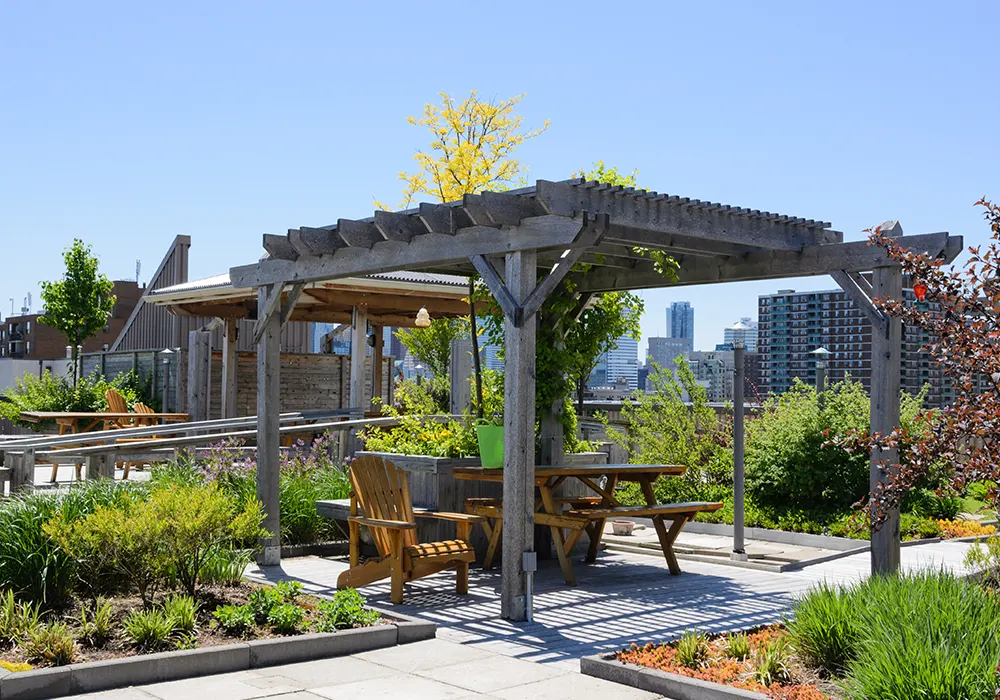Green Roofs

What is a Green Roof?
A green roof is a type of layered ballasted roof that consists of a growing medium and plants overlying a waterproof membrane. A green roof can replace a traditional roof and provide many benefits both immediately and over time.
The phenomenon known as the green roof is becoming more popular each year in an effort to reduce energy consumption, support biodiversity and make good use of typically unused space. Historically, green roofs — also known as ‘vegetated or ‘living’ roofs — appeared in parts of the world where building materials were limited, so turf was utilized as a roofing material. Today, green roofs replace a hard infrastructure with one that’s not only more efficient but also beautiful and useful.
It’s important to keep in mind that green roofs, like traditional roofs, require regular inspections to check for weathering, damage or drainage issues and to care for the vegetation. Like any garden, a green roof needs to be weeded and nurtured, fertilized and monitored to make sure that plants are healthy and the ecosystem is thriving. Talk to our experts to learn more about green roof maintenance.
Types of Green Roof
1. Intensive
2. Extensive
Green Roof Benefits

Some benefits include:
Stormwater management
The ecosystem created by a green roof uses stormwater rather than allowing it to run off into the city’s drainage system. In fact, by absorbing stormwater to provide nutrients and moisture to the soil and plants, a green roof can reduce the amount of stormwater runoff by 50–80%, helping to prevent sewer overflows. The vegetation can also catch airborne particulates like smog and heavy metals that typically get washed down into the gutters with the stormwater.
Energy efficiency
A green roof can provide an increased R-value and help to keep the building cool in the summer and warm in the winter by providing natural insulation. This reduces energy costs by allowing the heating and cooling system to work more efficiently. The reduction in energy usage also contributes to reduced greenhouse gas emissions associated with the operation of HVAC equipment.
Air quality
The vegetation of a green roof can reduce air pollution through the consumption of carbon dioxide emissions and the resulting production of oxygen. A green roof's plants remove harmful particles from the air as well as helps to reduce the urban heat island effect. These actions contribute to improving the health and comfort of a city’s occupants.
Longevity
Green roofs protect the roof’s membrane from weather occurrences such as wind, hail and rain as well as from the sun’s UV rays, allowing the roof to last up to twice as long as non-green roofs.
Biodiversity
Green roofs provide and support new habitats for native plants, animals and insects, such as bees, which are essential for life on earth and currently endangered. The vegetation on a green roof can include pollinating wildflowers for the bees and varied species of ground cover, flowering plants, small trees, herbs and more. For a green roof to readily support biodiversity, it should have varying substrate depths and plant types, both planted and seeded. This will encourage a larger mix of insects and animals to make the roof their home.
Short- & Long-term ROI of Green Roofs
Green roofs often have a higher initial cost than traditional roofs; however, over its lifetime, which can be up to twice as long as that of a traditional roof, a green roof can provide a significant return on investment by helping to save money on energy bills as well as provide the multiple short- and long-term benefits outlined above.
